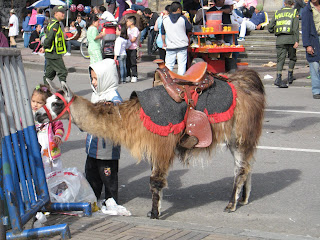So this weekend K., S. and I decided to check out some lovely towns four hours north of Bogotá in the department (read: state) of Boyacá. Apparently Boyacá is associated with Colombia´s independence, as a couple of important battles against Spain were fought there, and a number of Colombia´s forefathers like Antonio Nariño and some presidents spent time there (in Nariño´s case he died in Boyacá, specifically in Villa de Leyva, in a house which would be later made in two a museum to be visited by me).
Word of the day:
puenteYes puente does mean bridge. But did you also know that
puente means a long weekend?
Apparently Colombia is know for its puentes, though I am not sure about its bridges. It seems like there is a holiday every other week (so far it has fallen two weekends in a row including this past one), and it seems to fall on a Monday so many people can enjoy three days of relaxation, fun, or travel. Fun fact: there is also tiny bridge in Boyacá, called, you guessed it, the Puente de Boyacá, which serves as the center of a site of national monuments, which I think we actually passed by on one of our bus rides on Saturday.
So here´s how it went down, our trip that is. Bright and early Saturday, we trekked out to the bus terminal in Bogotá, which is rather out of the way, in a non-central location in the relative direction of the airport. We immediately hopped on a bus to Tunja, the capital city of Boyacá. Just as the road was becoming ever more spectacular, with mountains, valleys and much greenery, we arrived in Tunja. At first glance the city looks a bit worn, but as one heads toward the main plaza (and so far every substantive city in South America that I have come to know has an imposing, stylized main plaza, replete with
at least one church and one or more government buildings), which is called Plaza de Bolívar, just like in Bogotá, one begins to feel the a certain charm. This charm bounces of the antiquated buildings, the pedestrians, and little kids playing in the plaza. After taking some pictures and imbibing some caffeinated beverages, we strolled around Tunja and stopped by a small museum, the 16th century Casa de Don Juan de Vargas. Was Don Juan de Vargas a Don Juan? Unknown, but we were followed around by a group of Colombian soldiers, which seemed to have a certain noticeable effect on K. and S. Beside the usually period furniture and whatnot, the had a particular beautiful garden and interesting painted ceilings.
Anyway, we went along our merry way, hopping on another bus to Villa de Leyva, the main attraction of the trip. As soon as we stepped into its streets, we were charmed. If Bogotá is a ginormous eclectic hodge-podge (which I like because I love big cities), then Villa de Leyva is a compact unified masterpiece, painted in broad stokes of white and lined with large cobblestones. It is peaceful and beautiful, especially since it is surrounded by very smooth, rounded mountains, and it has been preserved to attract tourists, though not yet entirely overwhelmed by said tourists.
We stayed in a remarkable (and remarkably inexpensive) guesthouse called the Hospedería La Roca, right on the main plaza, this time called the Plaza Mayor. After having a wonderful late lunch/early dinner, we strolled about the city, wandering the streets, shops (one notable one sold whimsical knitted hats), and parks of Villa de Leyva. The town was actually celebrating its 438th birthday this weekend, and we caught a bit of the celebration concert in the plaza, though I turned in early to sleep after the past week of waking up at around 6 am to go on rounds.
Sunday morning we started off with huevos pericos, the Colombian breakfast staple of scrambled eggs with tomato and onion. Then after wandering around town some more (I stopped into the Museum dedicated to Antonio Nariño, see first paragraph, which also had period furniture and a nice garden, as well as some great balconies), we took a bus to Ráquira, a very small town 45 minutes out of Villa de Leyva. Ráquira is supposedly Colombia´s capital of pottery, and although I was not that impressed, I nevertheless appreciated the uniqueness of this colorful town. Here is where I split off from the girls, and decided to head back to Bogotá early.
Thinking I was smart by hoping on a Bogotá bound bus directly from Ráquira, I quickly realized that the bus was by no means a direct one, as it took a twisty unpaved road for about an hour and a half, dropping off random people who had spent the day at the Sunday market-festival in Ráquira. Undeterred, I took in the scenery, and about 4 1/2 hours and 1 bus change later, I stepped off at the Portal del Norte in the northern reaches of Bogotá. Here was where I ventured for the first time to take the Transmilenio, a special Rapid Transit bus system that has been under construction here over the last ten years. The system is pretty cool and fast, though crowded at all times and somewhat bumpy. It is a placeholder until Bogotá builds a subway system in the intermediate future, which I think for a city of its size and stature is
de rigeur.
Anyway, I finally got home in one piece (yes, my residence in Bogotá I suppose is a temporary home of sorts), and tomorrow, on the last day of this puente, am planning on exploring Bogotá, which I keep feeling is to vast to ever fully explore.





















